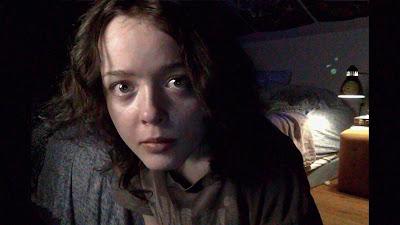Format: Streaming video from Hoopla on Fire!

When we dive into the stranger end of the cinematic swimming pool we have to be prepared not just for things to be strange, but for a lot of what we’re seeing to be metaphorical. That’s certainly the case with We’re All Going to the World’s Fair, a film that has been suggested to be about, essentially coming out, something confirmed by the writer/director Jane Schoenbrun, who is nonbinary. There are also potentially themes of gender dysphoria in this, and that’s not too hard to see.
There’s plenty in this movie that is going to pick the bones of some other classic horror. Specifically, this plays in part with the Bloody Mary myth or, movie-wise, Candyman. No one is looking in the mirror and saying the name five times, but there is something very similar happening here, and once it starts, we’re going to go on a very strange ride.
We’re going to spend most of our time with Casey (Anna Cobb), a lonely teen who decides to participate in the latest online craze. According to the trope that is passed around, the “World’s Fair Challenge” consists of saying the words “I want to go to the World’s Fair” three times, pricking your finger, and smearing blood on your computer screen. We watch Casey do this, and then see her watching a short video with strobe-like lights. Casey then tells us that she will post any changes.
What soon becomes apparent is that there is an entire World’s Fair subculture. People take the challenge and then post videos of what is happening to them afterwards. Everyone finds themselves changing in ways that they don’t really understand. They start to lose feeling of themselves, feeling essentially like plastic. They also seem to have moments of clarity where they realize what is happening to them as they change. Casey has similar symptoms, creating a video that talks about feeling like she did when she was younger and had a sleepwalking problem.
Eventually, Casey is contacted by a man calling himself JLB (Michael J. Rogers). He warns Casey that she is in danger and asks her to continue to make and post videos so that he can monitor what is happening to her. JLB, it turns out, is someone who watches a lot of World’s Fair videos and tracks what is happening to a lot of people.
Much of the film consists of Casey’s videos, which get increasingly disturbing. There are moments that smack of the Paranormal Activity series, and others that are far more mundane but include thoughts of murder and self-harm. Casey becomes increasingly destructive as well, eventually starting to destroy things that she cares about as she continues to lose her own sense of herself. In one of the more disturbing videos, she claims to not feel anything, then dances and sings, stops for a moment and screams in a sort of realization of what is happening to her, and then goes back to dancing again.
The idea that this is about gender dysphoria, or about coming out aren’t too hard to figure out. Something is clearly happening to Casey that she can’t explain, and she keeps saying that someday she will disappear and that no one will be able to find her. Could this be a metaphor for changing herself so completely that she’d be a different person? Are the changes that are happening to her both liberating and terrifying a part of that same metaphor? I don’t think it’s a stretch to say so. When she eventually says that her name isn’t actually Casey, there’s certainly a transgender reading of that line that makes a great deal of sense.
If there’s a downside to We’re All Going to the World’s Fair, it’s the overall look of the film. A lot of this is grainy, but it’s designed to be so because much of it is filmed on phones and webcams. It’s supposed to look like this, and that’s going to turn off people who get frustrated by what is frankly a Paranormal Activity or Blair Witch Project level of cinematography. I don’t have an issue with it because it makes sense for what the film is, but I can’t help but think there are going to be some people who find the look off-putting at best.
I like indie horror like this a great deal, because it’s often a great deal more inventive than the more mainstream films. Additionally, a lot of mainstream films seem to crib notes from films like this—you can see shades of this in the much more mainstream and better funded Talk to Me. Movies like this are why I started doing this blog, and I’m happy to have seen this.
Why to watch We’re All Going to the World’s Fair: It’s metaphorically dense.
Why not to watch: The production quality is going to turn off some people.
